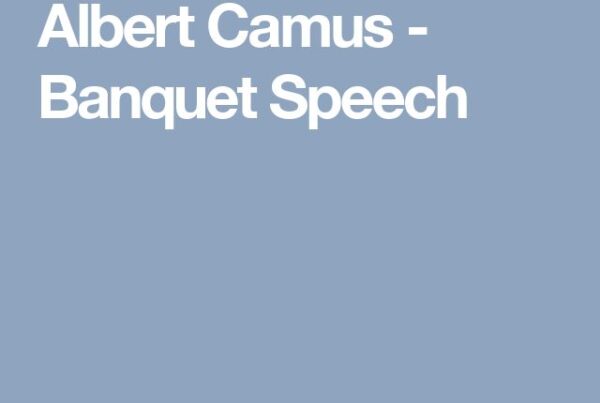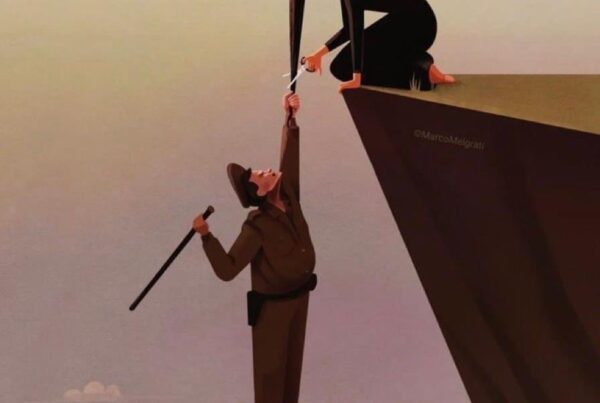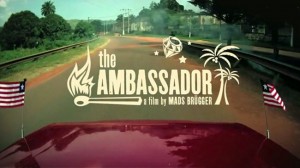 At the end of a screening at the International Documentary Film Festival Amsterdam (IDFA) a lady took the microphone and invited people to buy plastic bottles which were for sale right at the exit of the theatre. It was an initiative of an NGO working in the field of improving access to drinking water in Africa. The goal was to raise money to supply a village in South Sudan with clean water. I try to imagine the reaction of the audience. Some must have thought: yet another charity for our poor friends in Africa. Isn’t it enough that the government pays millions every year from our taxes helping aid to the third world countries? Others probably thought it would be a noble deed to let wealthy Europeans pay a few Euros and give hundreds of families access to the liquid of life. In the end the first ones will walk away indifferently and the second will buy some bottles. And this happens a lot at festivals. But whether it will really bring any change to the world or to what extent that change may be, nobody knows.
At the end of a screening at the International Documentary Film Festival Amsterdam (IDFA) a lady took the microphone and invited people to buy plastic bottles which were for sale right at the exit of the theatre. It was an initiative of an NGO working in the field of improving access to drinking water in Africa. The goal was to raise money to supply a village in South Sudan with clean water. I try to imagine the reaction of the audience. Some must have thought: yet another charity for our poor friends in Africa. Isn’t it enough that the government pays millions every year from our taxes helping aid to the third world countries? Others probably thought it would be a noble deed to let wealthy Europeans pay a few Euros and give hundreds of families access to the liquid of life. In the end the first ones will walk away indifferently and the second will buy some bottles. And this happens a lot at festivals. But whether it will really bring any change to the world or to what extent that change may be, nobody knows.
You could see this on the occasion of the screening of Hinterland, a documentary made by the Dutch director Albert Elings. He followed a former Sudanese child soldier, who came to the Netherlands 11 years ago as an asylum seeker, visiting his home country. Hence the full title of the film ,Hinterland-A Child Soldier’s Road back to South Sudan. The production properly began in 2002. Kon Kelei was then starring in Tussenland (Between countries) a feature film by Dutch filmmaker Eugenie Jansen who won one of the three Tiger Awards at the International Film Festival Rotterdam. At that time, documentary maker Albert Elings started to follow the expatriate. After the the country’s independence and the peace agreement between Khartoum and Juba, Kon Kelei returns home. The film follows him on this first trip to his birthplace where he has plans to open a school and insure drinking water for his community. It tells one of those stories we hear more and more in our time and which are the dream of millions of young people in the South, but at the same time they are a nightmare to the Western world.
Kon fled the Sudan more than a decade ago when he was recruited by the rebels as a child soldier. After a long journey on a containership he ended up in the harbour of Rotterdam. From that moment on his life would never be the same again. As a refugee in one of the asylum camps in the Netherlands, he could go to school and graduate in international law. Now he is back with a master in his pocket and a lot of dreams and plans to develop his new independent country South Sudan. The documentary follows the metamorphosis of the young man during almost ten years, from the moment he enters the asylum camp until he returns to his motherland. The film shows Kon Kelei in the camp, then during his graduating ceremony at the university of law in Nijmegen, and finally when he goes back to his family and his village in the deep inlands of South Sudan. It is nothing more than the story of a young refugee who grabbed the chance of success.
However, unconsciously, the film points out the gap between two worlds. Following Kon on his journey you see two ways of life; on the one hand there is the life he lived all those years in exile and on the other hand there is the life his family lives, which is, of course, the life he would have lived if he had not run away. This is when you see how absurd difference is in chance and unjustice between two worlds. This feeling is felt much deeper in the Netherlands, where the naive and optimistic message of the film is in complete contrast with the actual debate about the policy regarding underdeveloped countries. European countries are indeed facing a terrible economic crisis. In addition to budget cuts in fields such as culture and public services, they find the solution in reducing budgets for international development, which means retrenchment in the policy of sustaining the weak economies.
At the same time the recent case of the young Angolan Mauro Manuel, opened a highly animated debate about the decision to send him back to Luanda after ten years of exile, even though he has no more family in the African city. The fact is that Mauro is a very special case and far too complex for an emigration law that reduces human beings to numbers. The eighteen year old man came to the Netherlands as an eight year old boy. His mother put him on an airplane to save him from poverty, misery and civil war. In the Netherlands he was taken in by a family who tried to adopt him twice, without success. Still, the kid grew up in Dutch society quite like any other young boy: going to school, playing in the courtyards and hanging around in the parks. Now that he is and adult, this very rational society wants him to fit in somewhere. A case like this cannot be predicted by law. The boy went through the Dutch school system for ten years, he speaks the Dutch language like his mother tongue, he has Dutch friends and dreams of making a living in the only society he knows.
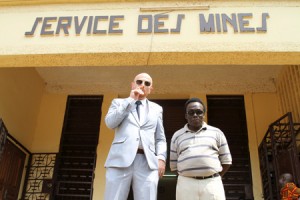
Whereas Mauro Manuel is still young (only eighteen), Kon Kelei is more grown up. He finished his master’s degree, and the young expert in international law has a brilliant future ahead of him. He is teaching at the newly founded university of law and will probably embrace a political career. The film shows many other south Sudanese young people like him, who are still in the process of getting their degrees. They are the incarnation of the dream of many young African men: go to the North, learn, make money and go back to serve the family, the tribe and the country. This brings us back to the sixties and seventies when African students were sent to Europe to graduate in different fields and take care of their people, once they got back home. Can we ever forget that this strategy led to all kinds of post-colonial regimes? The dictators that the people of Tunisia, Egypt and other African countries are now struggling against, are all well educated and graduated in Europe and the USA. All African ruling elite learned how to govern their people in Europe whether they physically went there or not.
From that point of view there is a very naive idea about the way the North is giving back something to Africa. One could not watch this film without thinking about the political and economic background of the refugee phenomenon. Such a film, even when it is clearly made with all good intentions, is then part of a widespread practice in the western world, which aims to ease people’s conscience: As you leave the film, you can buy a plastic bottle from a humanitarian organization which is raising money to develop drinking water in South Sudan. For a few Euros, people get the opportunity to ease their conscience and feel spiritually at peace. At the same time they let their governments send asylum seekers and immigrants back to the misery which they create with their unfair policy.
Worse still is that there is a huge dilemma in these kinds of situations. If you participate in the humanitarian effort you are an accomplice to a certain neo-capitalist system which you support indirectly. If you do nothing, you will not help the situation of millions of people improve or, at least, not worsen. That is how the neo-liberalist rulers of the world, by a perverse effect, use humanist values of solidarity and trap citizens in order to use their need for spiritual peace and mercifulness to save themselves from the obligation to fulfil their duty.
In these kinds of situations the nice mythical figure of Robin Hood comes to mind. The NGO is taking money from the rich to give to the poor. That is not a bad thing, one could say. But there are two counterarguments to this naive configuration. Firstly, NGOs are not steeling. Secondly, the people buying the plastic bottles are mostly not really the rich of the western world. Those who are steeling and the modern aristocrats profiting from the privileges of the neo-liberalism are the multinationals and the banks. At least one could see in the young former refugee an incarnation of the modern Robin Hood for whom the wealth he made thanks to his exile, could be seen, by way of a very subtle metaphor as a tax imposed on the rich, which he uses to help his poor people. The latter were robbed by the imperialist western companies and rulers.
Unfortunately this idea cannot be found in this film, nor in another, The Sacrifice (Yoole). This is a documentary by Moussa Sene Absa from Senegal, who points out the illegal migration on the coast of the Atlantic ocean. Asylum seekers or illegal migrants may be seen as the Robin Hoods of our time. Their plan is in fact to take the money from the rich and give it to the poor. But it in the legend of Robin Hood, the hero is of aristocratic blood. That is why I see more of the legend of the good thief in these European filmmakers who make a stand against the injustice of the neo-liberal machine crushing everybody and everything in its path; the poor would then be the Asian and the African peasants as well as the workers and the petit bourgeois in the wealthy European societies. But the workings of this kind of rollercoaster are more obvious on continents like Africa, where the absurd contradictions can be easily verified. That is why even if African cinema is not well represented at western festivals, African subjects are the subject ofmany documentaries made by directors in the North.
The 24th International Documentary Film Festival Amsterdam opened with The Ambassador, a film about the Central African Republic, made by Danish filmmaker and journalist Mads Brügger. Even before the kick-off of the festival and the screening of the film, a polemic had started between the filmmaker and one of the protagonists, the Dutch businessman Willem Tijssen, who asked the festival (through a letter) to withdraw the film. Tijssen runs a company called Diplomatic Services Africa and he helped the filmmaker acquire a Liberian passport. For that service he was paid a modicum sum of 50,000 US dollar. Three quarters of the amount was used to pay off corrupt African officers, the man admitted, while the entire payment was supposed to amount to 135,000 US dollars. It was not explicitly said whether he was contesting the way he was depicted in the film or whether he was not disgruntled because he had not been paid the rest of the money promised to him.
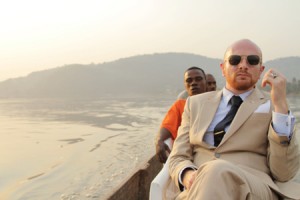 The journalist went to explore the world of diamond trafficking in the Central African Republic. This is one of the most secretive businesses in the world into which it would be impossible for an African filmmaker to enter. It is not enough to find the diamonds. The most difficult part is to succeed in taking them out of the country. The only safe way is to be a diplomat and therefore to be sure not to be searched by customs when you leave the country with soem diamonds in your Samsonite suitcase. As it is not possible for the journalist, a blond and tall Danish man,to become a western diplomat, he enters the central African territories as a Liberian official. After a number of adventures and dirty dealings he establishes his business. The whole process is filmed by a minuscule hidden camera. This way we enter a world of corrupt officials in the high and dark realms of Euro-African diplomacy.
The journalist went to explore the world of diamond trafficking in the Central African Republic. This is one of the most secretive businesses in the world into which it would be impossible for an African filmmaker to enter. It is not enough to find the diamonds. The most difficult part is to succeed in taking them out of the country. The only safe way is to be a diplomat and therefore to be sure not to be searched by customs when you leave the country with soem diamonds in your Samsonite suitcase. As it is not possible for the journalist, a blond and tall Danish man,to become a western diplomat, he enters the central African territories as a Liberian official. After a number of adventures and dirty dealings he establishes his business. The whole process is filmed by a minuscule hidden camera. This way we enter a world of corrupt officials in the high and dark realms of Euro-African diplomacy.
There is a lot to learn from these images. We are taught for example that after the fight for control of minerals in the seventies, these days France and China are working together to spoil the African soil. We learn how French secret services were involved in the provocation of central African rebellion(s). We are told that the Liberian president Ellen Johnson Sirleaf and her minister for foreign affairs were on a black list of people not allowed to hold any high official position because of their involvement in the civil war. We see how many European diplomats form a corrupt network, serving as intermediaries in the illegal trade of diamonds. They put you in touch with officials who will provide the false diplomatic passport, and with the local officials who will help you infiltrate whichever market you want. At the end of the film we come to the conclusion that the tall white people are earning hundreds of millions of dollars through the mines and the labour of the poor and small pygmies. The filmmaker doesn’t hesitate to show himself at all times standing beside his two local pygmies whom he took as assistants. In doing this he cynically visualizes the relationship of power and spoliation that weighs so heavily on Africans.
This documentary is part of a whole tradition of successful films on Africa. The same festival opened in 2008 with a film about the Congo called Enjoy Poverty by Dutch video-maker Renzo Martins, who explored the insane networks of foreign organizations working in this country. He showed how United Nations’ and Humanitarian NGO’s work in an area where the lives of the Congolese are wasted while westerners are making their fortunes by selling anything and everything: photos of corpses to newspapers and press agencies, medicines to sick malnourished children, diamonds and minerals to international traders, development plans to politicians. A couple of years earlier, Austrian filmmaker Hubert Sauper investigated the business of Nile perch fish in the Tanzanian Lake Victoria. He depicts the impact of hyper-production on the life of the locals, while the tasty fish dishes end up on the plates of European consumers. Can these filmmakers be associated with the image of Robin Hood ?
This brings me to another question, in fact: Is it an African destiny to always be spoken about, but never to speak itself? The weak, the subaltern of our time, is the one who is not able to talk, to represent himself. That is the philosophy upon which the policy of hegemony has been built for ages. Taking away the other person’s right to speak is a part of the strategy to dominate and despoil. But if the subaltern cannot represent itself, it must be represented. That is where many European filmmakers can play an interesting role: give back the rightful owner something that has been unfairly taken from him. Unfortunately in this case filmmakers can do nothing to bring back all the diamonds and minerals stolen by the westerners. What they can restore is an image of what is happening. From that point of view they operate in the field of media and representation of the other person. Hopefully the films will somehow help to denounce the inhumane practice and hence reduce the suffering of millions who cannot not do so for themselves.
To what extent can European filmmakers substitute their colleagues from the South? Not everybody can be Robin Hood, only those who have the wealth, the blood, the know-how and the education. In a word and in our modern context, one needs to be rich enough to be able to raise his/her voice. As a matter of fact, production circumstances can be so hard that Africans can be less free than European filmmakers. Hence it is not always obvious that an African filmmaker will be better suited to speak about his/her continent than a non-African. She/He would never be able to do what the Danish director did. Not only because it is a huge financial operation, but also because an African diplomat who is blond, is such an unexpected ironic situation that it is the most eloquent one to show how absurd the African context is, and how far the “White” can go in the process of dispossession of the other from its most primordial identity.
Our world is definitely a tragedy and doesn’t fit with the legend of Robin Hood which is more like a fairytale, ending happily in reestablishment of the good prince to the joy of the people. None of the 1% of human beings will dare espouse the cause of the other 99%. The latter now perhaps occupy the squares as the legendary thieves once hid in the woods. But the good prince who will lead them to fight the injustice is unfortunately from another time and will probably never come back, as long as we don’t consider that filmmakers are dreaming of changing the world by helping the poor and denouncing the real thieves as modern avatars of Don Quixote fighting windmills.
Hassouna Mansouri is film critic and researcher in Cultural Stides focusing on Otherness and Hybridiy.

